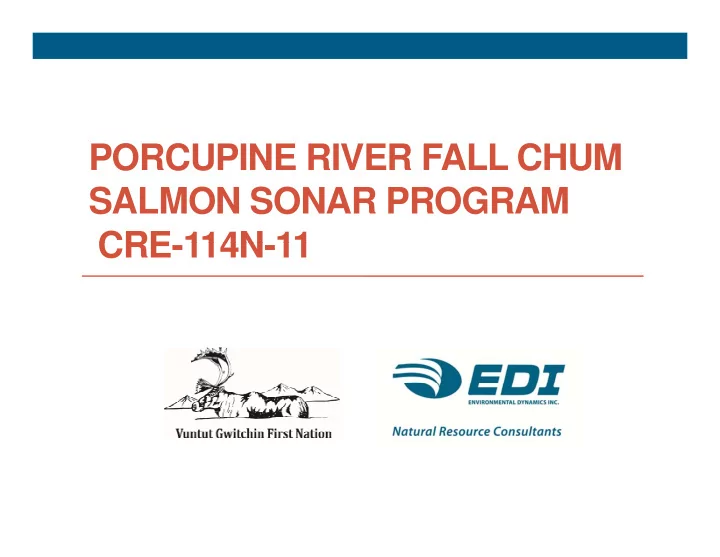

PORCUPINE RIVER FALL CHUM SALMON SONAR PROGRAM CRE 114N 11 CRE-114N-11
Introduction Introduction • Presenting a summary of the 2011 Porcupine River fall g y p chum salmon sonar enumeration program. • Program conducted by the Vuntut Gwitch’in First Nation Government (VGG), in Old Crow, Yukon. • EDI Environmental Dynamics is a Natural Resource consulting company contracted by VGG to assist with project planning, field activities and reporting.
Presentation Outline Presentation Outline • Introduction • Background Info • Rationale • Sonar Basics • 2011 Field Program – Overview • Results • Comparison to Fishing Branch River Weir • Summary • Summary
Porcupine River Porcupine River
Project Rationale Project Rationale • Porcupine River an important salmon drainage in the p p g territory. • Two important CU s, Crow and Porcupine Rivers. Two important CU’s Crow and Porcupine Rivers • Different stock assessment techniques have been tried for Different stock assessment techniques have been tried for chum salmon, downstream of Old Crow: Chum Mark/Recapture Program (2003 to 2008) Chum CPUE Index (2009 to 2010) Ch CPUE I d (2009 t 2010) • Difficulties with all these techniques. q
Project Rationale Project Rationale • Vuntut Gwitch’in Government and local community y supportive of developing a sonar index program for fall chum salmon. • Sonar may offer a more accurate, less intrusive and more cost effective option (over long term) for assessment of cost effective option (over long term) for assessment of the upper Porcupine River fall chum salmon stock. • Local employment and capacity building opportunities.”.
Sonar Basics Sonar Basics Sonar pings bounce of objects and the time elapsed before the echoes return to the source allows calculation of distance.
Site Selection Site Selection • A few basic requirements for sonar sites: q Even and smooth bathymetric profile Smooth river bed material (cobbles) Laminar flow pattern Laminar flow pattern Single channel free of bars, islands or other obstructions. Searched for a site in 2009, located a suitable site and tested it for a week long trial in 2010. Site showed good potential potential.
Porcupine River Sonar Site Porcupine River Sonar Site
Porcupine River Sonar Site Porcupine River Sonar Site
2011 Field Program Overview 2011 Field Program - Overview • Selection of sonar equipment q p • Hiring and training of local crew • Setting up sonar equipment • Collecting and reviewing data • Test netting
Selection of Sonar Equipment Selection of Sonar Equipment • SIMRAD ES-60 split-beam sonar system used for p y Porcupine River sonar program: Long range Can have narrow (2.5 °) beam width Effective in turbid water conditions
Hiring and training of local crew Hiring and training of local crew
SIMRAD split beam transducers SIMRAD split-beam transducers • Transducer (orange) is mounted on a steel frame. Pitch adjusted using hand crank and by adjusting legs. • Sonar placed instream and connected to topside control/laptop in shore via long data cable.
Fish Deflection Fence Fish Deflection Fence Set up a fish deflection fence downstream of sonar mount to deflect fish around front of transducer, also keeps fish from swimming behind transducer.
Laptop/topside controls Laptop/topside controls Computer onshore controls sonar, data stored on backup drive and reviewed in sonar tent.
Collecting and Reviewing Data Collecting and Reviewing Data Data recorded using SIMRAD supplied software (ER60), reviewed using Echotastic V 2 provided by Carl Pfisterer and ADF&G using Echotastic V.2, provided by Carl Pfisterer and ADF&G.
Determining Direction of Travel Determining Direction of Travel Orientation of the colors indicate if a fish is travelling upstream or downstream downstream.
Test Netting Test Netting Drift netting conducted to apportion sonar counts, drifted onshore and offshore of both banks.
Results Results – Sonar Data Sonar Data • A total of 11,296 fish targets with upstream motion were , g p counted between August 21 to September 22. • Interpolating of the total counts resulted in a revised total of 12,348 fish targets with upstream motion. • Location of vast majority of fish targets were within 20 m of the transducer on both banks.
Results Results – Test Netting Test Netting • Drift Netting resulted in a capture of 73 fish: 71 chum g p salmon, 1 longnose sucker and 1 broad whitefish. • This indicates that the majority of sonar counted fish were chum salmon
Comparison to Fishing Branch River Weir Comparison to Fishing Branch River Weir • The Fishing Branch River weir provides a count of chum g p salmon in the Fishing Branch River, a large tributary to the Porcupine River. • The weir and sonar are separated by approximately 350 km of river length or 9 days travel time. km of river length or 9 days travel time.
Comparison to Fishing Branch River Weir Comparison to Fishing Branch River Weir Sonar and weir counts show similar trends during the period of overlap of both programs.
Comparison to Fishing Branch River Weir Comparison to Fishing Branch River Weir Cumulative sonar counts are higher than corresponding adjusted weir counts at the end of the sonar program.
Summary Summary • 2011 program demonstrated that sonar can be used to p g provide an index of chum salmon on the Porcupine River. • Continuation of the sonar program in future years could • Continuation of the sonar program in future years could lead to the development of real-time in-season chum salmon passage data for Old Crow and the upper Porcupine River Could also be done for Chinook Porcupine River. Could also be done for Chinook. • Through this program, development of local capacity for g g y fisheries programs. Strong interest in the sonar program in the community.
Recommend
More recommend